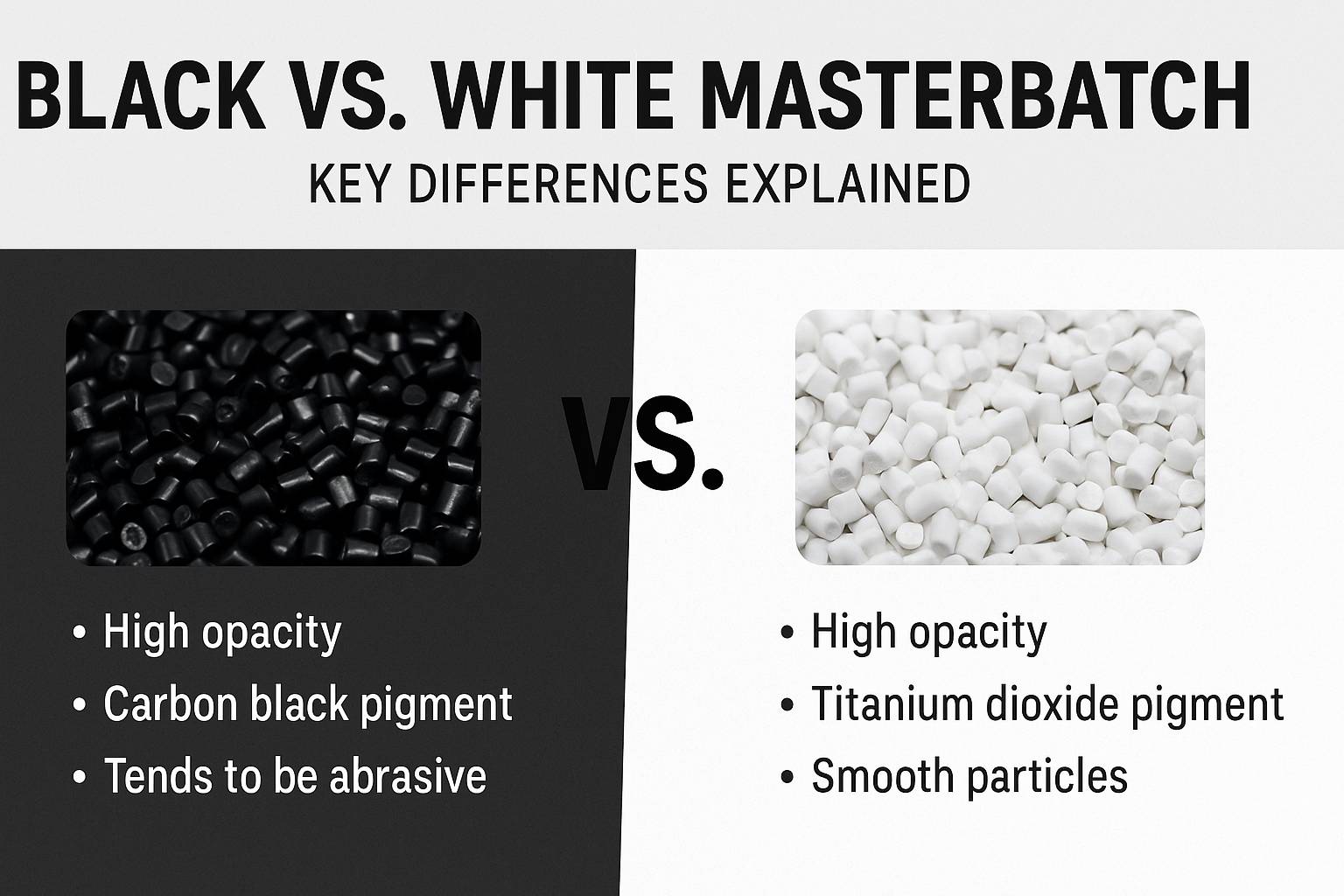Black vs White Masterbatch Key Differences Explained
Black vs White Masterbatch: Key Differences Explained
In the plastics manufacturing industry, the choice of masterbatch plays a crucial role in determining the performance, aesthetics, and functionality of the final product. Among the various types of masterbatches available, black and white masterbatches are two of the most commonly used. Although they may appear to serve similar purposes—coloring plastic—they are significantly different in their composition, functionality, and application. In this detailed guide, we focus on Black vs White Masterbatch Key Differences Explained, offering insights into how they compare and when to use each.
What is a Masterbatch?
A masterbatch is a solid additive used in plastics to impart color or enhance performance characteristics. It consists of pigments or additives encapsulated in a carrier resin. These granules are then mixed with the base plastic during the manufacturing process to ensure uniformity and consistency in color or functionality.
Masterbatches are generally classified based on their color or the function they serve—color masterbatches (like black and white) or additive masterbatches (such as UV stabilizers, flame retardants, etc.).
Composition Differences
The first major point of comparison in Black vs White Masterbatch Key Differences Explained is composition.
-
Black Masterbatch contains carbon black as the main pigment. Carbon black is known for its excellent UV resistance, high tinting strength, and electrical conductivity. It is often blended with polymers like polyethylene (PE), polypropylene (PP), and polystyrene (PS).
-
White Masterbatch, on the other hand, uses titanium dioxide (TiO₂) as the main ingredient. TiO₂ provides high whiteness, brightness, and opacity. The concentration of TiO₂ can vary depending on the desired effect, typically ranging between 30% to 70%.
Both types of masterbatch also include carrier resins and sometimes additional additives to enhance properties such as dispersion, heat resistance, or processability.
Functional Applications
Both black and white masterbatches are used across a wide variety of industries. However, their applications vary greatly based on performance requirements.
Black Masterbatch Applications
-
Automotive components: High UV resistance and durability.
-
Agricultural films: Protection from sunlight and environmental degradation.
-
Pipes and cables: Electrical insulation and increased lifespan.
-
Industrial packaging: Enhanced appearance and functionality.
White Masterbatch Applications
-
Food and pharmaceutical packaging: Brightness, safety, and compliance with regulations.
-
Household goods: Aesthetic appeal and consistent coloration.
-
Textile fibers and films: Opacity and smooth surface finish.
-
Medical devices: Biocompatibility and regulatory safety.
This clearly shows why understanding Black vs White Masterbatch Key Differences Explained is vital when selecting a masterbatch for specific industrial needs.
Properties and Performance
The performance of each masterbatch differs due to the unique properties of their pigments.
-
UV Resistance: Carbon black in black masterbatch provides superior UV resistance, making it ideal for outdoor use. TiO₂ in white masterbatch also offers UV protection but to a lesser extent.
-
Thermal Stability: Black masterbatches generally exhibit greater thermal stability. White masterbatches need specially treated TiO₂ to withstand high processing temperatures without yellowing.
-
Opacity: White masterbatches are formulated to achieve high opacity and brightness, while black masterbatches require less pigment to achieve full coverage due to carbon black’s strong tinting power.
-
Dispersibility: Both require excellent dispersion for consistent quality. Poor dispersion leads to streaks, uneven coloration, or defects in final products.
The clarity offered by Black vs White Masterbatch Key Differences Explained helps manufacturers match properties to application requirements more precisely.
Environmental and Regulatory Considerations
Environmental and safety regulations play a key role in masterbatch selection. Carbon black is classified by the IARC as possibly carcinogenic when inhaled in powder form. However, in masterbatch form, it is considered safe and is used widely. White masterbatches, especially those using food-grade TiO₂, are often preferred for sensitive applications like food packaging and healthcare products.
There are also increasing concerns about the environmental impact of TiO₂ and carbon black production, prompting the industry to explore more sustainable alternatives. Nevertheless, black and white masterbatches remain indispensable due to their effectiveness and cost efficiency.
Cost and Economic Impact
From a cost perspective, black masterbatches tend to be more affordable. Carbon black is less expensive than titanium dioxide, which makes black masterbatches a cost-effective solution for applications where color and UV stability are priorities. However, in applications where brightness, purity, and food contact safety are important, the higher cost of white masterbatch is justified.
Additionally, highly loaded white masterbatches may offer better economics through lower let-down ratios and reduced consumption in the long run.
Choosing the Right Masterbatch
Selecting the appropriate masterbatch involves several considerations:
-
Final application: Does the product require high UV resistance or aesthetic appeal?
-
Regulatory needs: Is the product intended for food contact or medical use?
-
Processing conditions: Will the plastic undergo high heat or high shear during production?
-
Cost constraints: Are there budget limitations that impact pigment choices?
A thorough understanding of Black vs White Masterbatch Key Differences Explained provides clarity and confidence in making informed purchasing and formulation decisions.
Conclusion
Though black and white masterbatches may seem to serve similar functions, they are designed for different purposes, driven by the chemistry of their pigments and their intended applications. The knowledge of Black vs White Masterbatch Key Differences Explained empowers manufacturers to not only select the right masterbatch for performance and compliance but also to optimize costs and improve product quality. Whether it’s the weather-resisting strength of carbon black or the clean brightness of titanium dioxide, each masterbatch serves a specific role in plastic product design and development.


